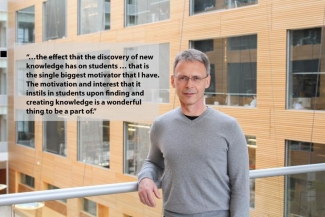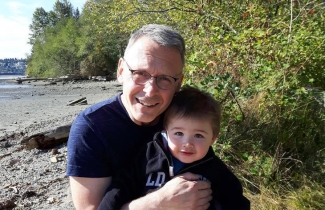This week, we chat with Prof. Ed Pryzdial, a scientist with Canadian Blood Services' Centre for Innovation, and associate director of the Centre for Blood Research at the University of British Columbia.
Prof. Ed Pryzdial was one of the first people that I met when I joined the Centre for Blood Research (CBR) at UBC. I remember in our first encounter when I introduced myself to him he said, “I know you; I knew you were joining the CBR before you knew!” Ever since, I always thought of Ed (Pryzdial) as the best friend of Ed (Conway), but I also got to see him frequently in our joint lab meetings. I thought of him as the smart person in the room who asked the most critical questions after the students’ presentations, the kind of person that you secretly wished was not in the room when you presented, but someone I never really got to know closely. Recently, I had the opportunity to interview Ed, and discovered that he has very sage, while at the same time humorous, wisdom that makes you want to sit and listen for hours, if he lets you!

How long have you been with Canadian Blood Services? How did you start?
I started in 1990 with the Red Cross-operated blood system that subsequently became Canadian Blood Services. Not long before then, it was like a postdoc’s fantasy coming true! I went to my first big meeting as a postdoc, and somebody saw me from across the auditorium - a professor for whom I had analyzed some data during my PhD. She had moved to the Red Cross and informed me that several scientist positions had been created to build a protein chemistry laboratory. She said that I should apply. With still 2 more years left on my postdoctoral fellowship, I applied, and I got the job. They kindly waited until I finished my postdoc.
What’s your role? How do you fit within your organization?
As a scientist with the Centre for Innovation, I am part of a network of Canadian Blood Services scientists located at academic centres across Canada. As the associate director with Centre for Blood Research, I assist Ed Conway (the director of the CBR) whenever he needs some help. Sometimes he bounces ideas off me. I would say I am the background backup. Also, I am involved in a lot of CBR’s committee work, which I thoroughly enjoy.
Where is your lab?
I don’t know! (He walks out and checks the room number.) Well, it is room 4230, at the Life Sciences Institute, UBC.
Tell us a bit about your areas of research? What are you working on now?
All of the research in my lab focuses on new functions for the old players in the coagulation system, which overlaps with several areas. Our two main interests are: first, how clots are broken down, and second, how viruses exploit the blood clotting proteins that exist in blood. This has important avenues within the transfusion system because we are trying to understand more and more about what the plasma proteins are doing. Ultimately, our goal would be to contribute to making artificial blood and find new applications for plasma proteins.
We are also involved in contributing to the safety of our blood system because of our interest in developing “pan-selective anti-viral” agents. We are hoping to identify a molecule common to the surface of many different viruses so we can target all of them with one drug. Actually, I think we have found it, and it is a cellular protein. Being a cellular protein means that any virus that obtains an envelope covering from the host cell can have that protein on its surface as long as the virus replicates in a cell type that expresses the protein. We are excited since many envelope viruses replicate in such cells (like dengue virus, hepatitis A and B viruses, influenza A and B virus, HIV, Zika virus, West Nile virus and Ebola virus). We already have ways to prevent infection of normal human cells and mice based on this protein.
Click here to learn more about Dr. Pryzdial’s work revealing that dengue — the most common virus spread by insects — hijacks blood platelets and commandeers the machinery inside the platelet to reproduce infectious virus. This previously unknown mechanism helps researchers better understand how dengue virus works, and helps blood operators like Canadian Blood Services recognize the possible risk this infectious agent poses to blood safety.
Why did you get into science?
I liked it! I am very happy about the situation that I have right now. I am a Canadian Blood Services employee, not a UBC employee, but since my lab is on campus I have the beauty of being in both worlds! Canadian Blood Services is a large biologics manufacturer, and is regulated by Health Canada. So, as their employee, I have kind of an industrial perspective, more than most professors. Yet, I also have the pleasure of being an academic scientist at UBC. I guess I have the disadvantages of both systems too, but primarily it works out pretty well.
What inspires you?
That is a tricky question. Inspiration is derived from so many sources. If I want to talk about that light bulb “AHA!” kind of an idea, I often find that those materialize when I am alone, silent, and thinking, as opposed to when people continually distract me asking for interviews!
What do you find most exciting about your work?
There is one clear answer to that, and that is the effect that the discovery of new knowledge has on students. That is the single biggest motivator that I have. The motivation and interest that it instils in students upon finding and creating knowledge is a wonderful thing to be a part of.
What work are you most proud of?
I have a great grandson (no, not a great-grandson!) — he is awesome! He is two years old.

When you’re not in the lab where could we find you? What are your hobbies?
I play jazz guitar, I sculpt rock, I fly fish, and I am a yoga enthusiast. Sometimes I watch a movie. If I would like to categorize it, I really like “chick-flicks”, that kind of light, fluffy romance movie. For books, I try to keep away from New York’s time’s best sellers. I subscribe to the Acoustic Guitar Player magazine and Fly Fisherman magazine, so I read those. In terms of books, among my favorites have been biographies of musicians and music-type books.
(While making me a perfect cup of tea…) I have an obsessive-compulsive character, as you can tell by having 10 different kinds of tea and 4 decaf coffees in my drawer! I go all over the city to find decent decaf beans. In my office I have a digital scale where I weigh and then grind them, because grams per liter must be tweaked just right for each coffee to be perfect! I love the whole ritual …
Subscribe to the Research & Education Round Up to stay up to date on research publications and funding opportunities.
Visit our Funded Research Projects to view projects funded by Canadian Blood Services.
Canadian Blood Services – Driving world-class innovation
Through discovery, development and applied research, Canadian Blood Services drives world-class innovation in blood transfusion, cellular therapy and transplantation—bringing clarity and insight to an increasingly complex healthcare future. Our dedicated research team and extended network of partners engage in exploratory and applied research to create new knowledge, inform and enhance best practices, contribute to the development of new services and technologies, and build capacity through training and collaboration.
The opinions reflected in this post are those of the author and do not necessarily reflect the opinions of Canadian Blood Services nor do they reflect the views of Health Canada or any other funding agency.
Related blog posts
This week, we catch up with Dr. Ed Conway, the director of the Centre for Blood Research at the University of British Columbia and a Canadian Blood Services adjunct scientist.
